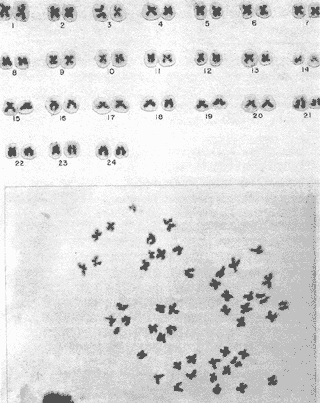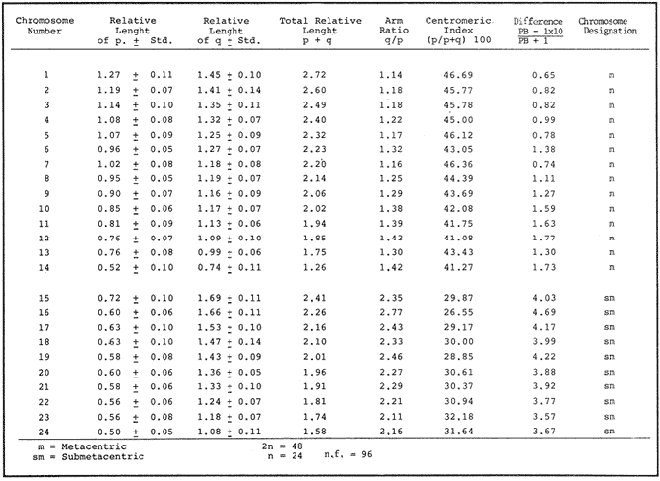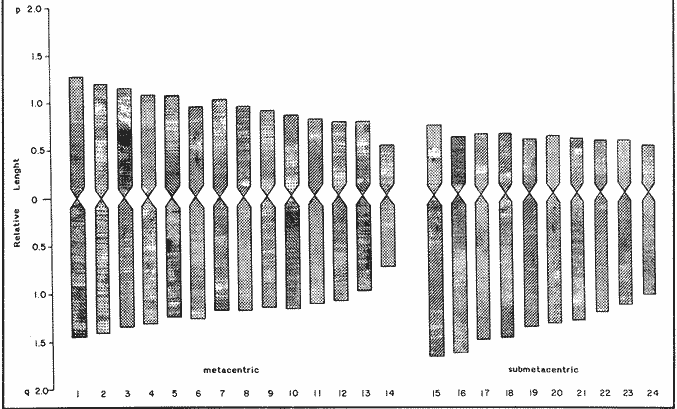|
CYTOGENETIC STUDY OF Centropristes
ocyurus Jordan and Evermann (PISCES: SERRANIDE)
Trabajo recibido el 8 de
enero de 1990 y aceptado para su publicación el 6 de marzo de
1990.
Alicia Luz Durán-González
Alfredo Laguarda-Figueras
Instituto de Ciencias
del Mar y Limnología, Universidad Nacional Autónoma de
México. Contribución No. 673 del Instituto de Ciencias del Mar y
Limnología, UNAM. Trabajo presentado en el IX Congreso Nacional de
Zoología, efectuado del 13 al 16 de octubre de 1987 en Villahermosa
Tabasco, México.
Los peces de la Familia Serranidae
han sido ubicados filogenéticamente en la base de la evolución
del Suborden Percoidei, tomando en cuenta fundamentalmente sus
características morfológicas. De hecho, dentro de esta familia se
han incluido los géneros y especies más primitivos del Suborden
Percoidei, así como agrupado diversas especies hermafroditas, cuya
ubicación no es clara. Con el fín de coadyuvar a esclarecer lo
anterior, se procedió al estudio citogenético de organismos de la
especie Centropristes ocyurus capturados en el Caribe
Mexicano, para analizar las características de sus complementos
cromosómicos y compararlos con los otros taxa con los cuales la especie
mencionada presenta diversos grados de parentesco. Los organismos estudiados
muestran un número diploide de 2n = 48 cromosomas, de los cuales 14
pares son metacéntricos y 10 son submetacéntricos. El cariotipo
presenta el mayor número total de brazos de n.f. = 96 en virtud de que
los 48 cromosomas son birrámeos. No hubo evidencia de cromosomas
sexuales. El cariotipo difiere del patrón de 48 cromosomas
crocéntricos considerado como el ancestral más primitivo desde el
punto de vista citogenético.
The fishes of the Serranidae Family
have been located from the phylogenetical point of view in the evolutionary
base of the Percoidei Suborder, taking in account, fundamentaly, its
morphologic characteristic. In fact, there have been included in this family
the most primitive genera and species of the Percoidei Suborder; and so it has
been formed a group of diverses hermaphrodite species which location is not
clear. In order to help to enlight the above, it was done a cytogenetic study
of organisms of Centropristes ocyurusspecies, collected in
the Mexican Caribbean Sea, in order to analize the characteristics of its
chromosomic complements and to compare it with those of other taxa with a
diverse kindred relationship. The studied organisms show a diploid number of 2n
= 48 choromosomes, from which 14 pairs are metacentric and 10 are
submetacentric. The karyotype presents the major chromosome arm number of n. f.
= 96 because the 48 chromosomes were biarmed. No evidence of sexual chromosomes
exists in this species. The karyotype differs of the 48 acrocentric chromosomes
which is considered as the most primitive ancestral pattern from the
cytogenetical point of view.
Due to the Serranidae family is located phylogenicaly in the base of the Suborder Percoidei, cytogenetic studys are particularly important. This suborder along with other 15 suborders from the Perciforms Order, which is one of the richer and more varied, in number of suborders and families, of the 31 orders that compound the Osteichthyes Class (Nelson, 1984). Moreover, this family presents a very interesting taxonomical problem (Kendall, 1979), because all the fishes that can not be included in any other family due to their morphological characteristics, have been located in it. Also, it is the receptor of all the lower percoidei which are not accepted in other taxa (Gosline, 1966). In accordance with the Mexican Marine Fishes Catalog (Ramírez-Hernández and González-Pages, 1976), published by the National Institute of Fisheries, of the Fisheries Secretariat of Mexico, this family is represented in the Mexican waters by 14 genera, meanwhile Castro - Aguirre (1978) considers that there are only 7 genera; being common for both cases only 5 genera. According lo Miller (1959)Centropristes ocyurus is located from Cape Hatteras in North Carolina, U. S. A., to Yucatan, Mexico, with a limited distribution. The populations of this species forms part of the bentonic ictiofauna of the Mexican Caribe; they are an exploted local consumption resource, taking in account its quality as fresh seafood (Yáñez et al., 1985). The studied species in this work belongs to the Centropristes genus, which is formed by 4 species: C. striatus, C. philadelphicus, C. ocyurus andC. melanus (Miller, 1959). Among these species there is a high number of "synonymias". For instance, the C. Striatuspopulations receive diverse names depending on the geographic location. TheC. ocyurus presents 3 "synonymias" and was considered a deep water variety of C. striatus. According with the above, it is of particular importance the cytogenetic study ofCentropristes ocyurus organisms caught in the Mexican Caribbean Sea, in order to know the characteristics of its chromosomic complements and to compare them with those of other taxonomic entities closely related. COLLECTING AREAThe studied organisms were collected and processed on board of the B/O "Justo Sierra" vessel, during the oceanographic campaigns "Prospección Caribe Mexicano PROIBE III" and "V", which took part in April of 1985 and February of 1986, respectively. The specimens were caught in the area located between the 21°45'-22°20' North latitude and the 86°45'-87°10' West longitude, at variable deeps between the 44 and 60 meters, which determine the sample area located in the Yucatan Channel (Fig. 1). MATERIAL AND METHODSTen organisms, male and female, were treated by the techniques of McPhail and Jones (1966), Denton (1973) and Kligerman and Bloom (1977). Sixty metaphases were analyzed, and 11 mitotic fields (9 from male and 2 from female), showed a complete chromosomic complement. In order to stablish the karyotype, mitosis with a high definition of the chromosomes and adequated concentration of chromatine (not very high) were chosen. Those fields with overlapping chromosomes were omited (Fig. 2). The chromosomes were classified by the methods propoused by Levan et al (1964) and Al-Aish (1969). RESULTSAccording with the statistical analysis of the chromosomic complements, Centropristes ocyurus presents a karyotype formed by 48 chromosomes from which 14 pairs are metacentric and 10 pairs submetacentric (Table 1, Fig. 3 and Fig. 4) and the major chromosome arm number is n. f. = 96 because the 48 chromosomes are biarmed. Chromosomic heteromorphism or negative heteropygnosis which make evident the presence of sexual chromosomes was not found DISCUSSIONSome authors (Ohnoet al., 1968; Denton, 1973; Thompson, 1979; and Uyenoet al., 1983) consider that the karyotype of the ancestral teleost fishes was of 48 achrocentric chromosomes, taking in to account that the karyotypes with biarmed elements (metacentric or submetacentric) are more evolved, because they come from the monoarmed chromosomes (acrocentric: telocentric). From the cytotaxonomic point of view the studied species shows a considerable evolved karyotype among the serranidae fishes, since all the chromosomes are biarmed and the n. f. = 96. This point of view is in accordance with Smith and Young (1966), because they consider that theCentropristes genus has his own morphologic characteristics and an accentuated sexual dimorphism, being a protogenic hermaphrodite  Figure 1. Collecting area of Centropristes ocyurus.  Figure 2. Mitotic fields of Centropristes ocyurus.  Figure 3. Karyotype of Centropristes ocyurus.  TABLE 1 RESULT OF THE STATISTICAL ANALYSIS OF THE KARYOTYPE'S CHROMOSOMES OF Centropristes ocyurus  Figure 4. Idiogram of Centropristes ocyurus. ConclusionesCentropristes ocyurus shows a diploid number of 48 chromosomes from which 14 pairs are metacentric and 10 pairs are submetacentric. Due to the 48 chromosomes are biarmed the karyotype presents a fundamental number of 96. No evidence of sexual chromosomes exists in the species. For such reasons it is a very evolved species from the cytotaxonomic point of view. AgradecimientosThe authors are grateful to Enrique Lozano-Alvarez and to Felipe Flores-Andolais from the Estación de Investigaciones Marinas Puerto Morelos of the Instituto de Ciencias del Mar y Limnología of the Universidad Nacional Autónoma de México (UNAM) for the help given in the participation in the oceanographic campaigns "Prospección Caribe Mexicano PROIBE". Likewise, we thank to Patricia Fuentes-Mata and Héctor Espinosa-Pérez from the Instituto de Biología of UNAM for the classification of the Biological Material. LITERATURAAI-AISH, M. Can. J. Genet. and Cytol. Human chromosome morphology. I. Studies on normal chromosomes characterization and karyotyping. 1969.370- 381. 11: CASTRO-AGUIRRE, J. L.Catálogo sistemático de los peces marinos que penetran a las aguas continentales de México con aspectos zoogeográficos y ecológicos. Serie Científica Ed. Depto. de Pesca. Direc. Gral. de Inst. Nal. de Pesca.D.F. México1978. 298p. No. 19 DENTON, T. E. Fish Chromosome Methodology. Charles C. Thomas Publisher. U. S. A. 1973. 466 p. GOSLINE, W. A. Proc. Cal. Acad Sci.The limits of the fish family Serranidae, with notes of other lower percoides. 4th series.1966. 91-112. 33: KENDALL, A. W. Jr. Morphological comparisons of North American sea bass larvae (Pisces: Serranidae). U. S. Dep. Commer. NOAA Tech, Rep. NMFS Circ.1979. 50 p. 428: KLIGERMAN, A. D. and S. E BLOOM J. Fish. Res. Board. Can. Rapid chromosome preparations from solid tissues of fishes. 1977.266 - 269.34: LEVAN, A., K. FREDGA and A. A. SANDBERG. Hereditas Nomenclature for centromeric position on chromosomes.1964. 201-220. 52: McPHAIL, J. D. and R. L. JONES. J. Fish. Res. Board Can. A simple technique for obtaining chromosomes from teleost fishes. 1966.523: MILLER, R. J Tulane Studies in Zoology A review of the seabasses of the genus Centropristes (Serranidae). 1959. 34-68.(2) 7 NELSON, J. S. Fishes of the worldWiley Interscience2a. Ed. U. S. A. 1984. 416p OHNO, S., U. WOLF and N. B. ATKIN. Hereditas Evolution from fish to mammals by gene duplication.1968. 169 - 187. (6):59 RAMÍREZ-HERNÁNDEZ, E. and A. GONZÁLEZ-PAGES. Catálogo de peces marinos mexicanos. Sría. de Industria y Comercio, Inst. Nal. de Pesca. D.F.México 1976. 462 p. SMITH, C. L. and P. H. YOUNG. Calif Fish. and GameGonad structure and the reproductive cicle of the kelp bass, Paralabrax clathratus (Girard), with comments on the relationships of the serranid genus Paralabrax1966. 283 -292. (4):52 THOMPSON, K. W.Copeia Cytotaxonomy of 41 species of Neotropical Cichlidae. 1979.679-691.4: UYENO, T., R. R. MILLER and J. M. FITZSIMONS Copeia Karyology of cyprinodontoid fishes of the mexican family Goodeidae.1983.497-510.2: YÁÑEZ-ARANCIBIA, A., P.SÁNCHEZ-GIL y A. L. LARA-DOMINGUEZ. Recursos pesqueros potenciales de México: La Pesca Acompañante del Camarón. Inventario evaluativo de los recursos de peces marinos del sur del Golfo de México: Los recursos actuales, los potenciales reales y perspectivas. In: Yáñez-Arancibia, A. (Ed.) Prog. Univ. de Alimentos, Inst. Cienc. del mar y Limnol. Inst. Nal. de Pesca, UNAMD.F.México1985. 255-274., 748 p. Cap. 6
|

